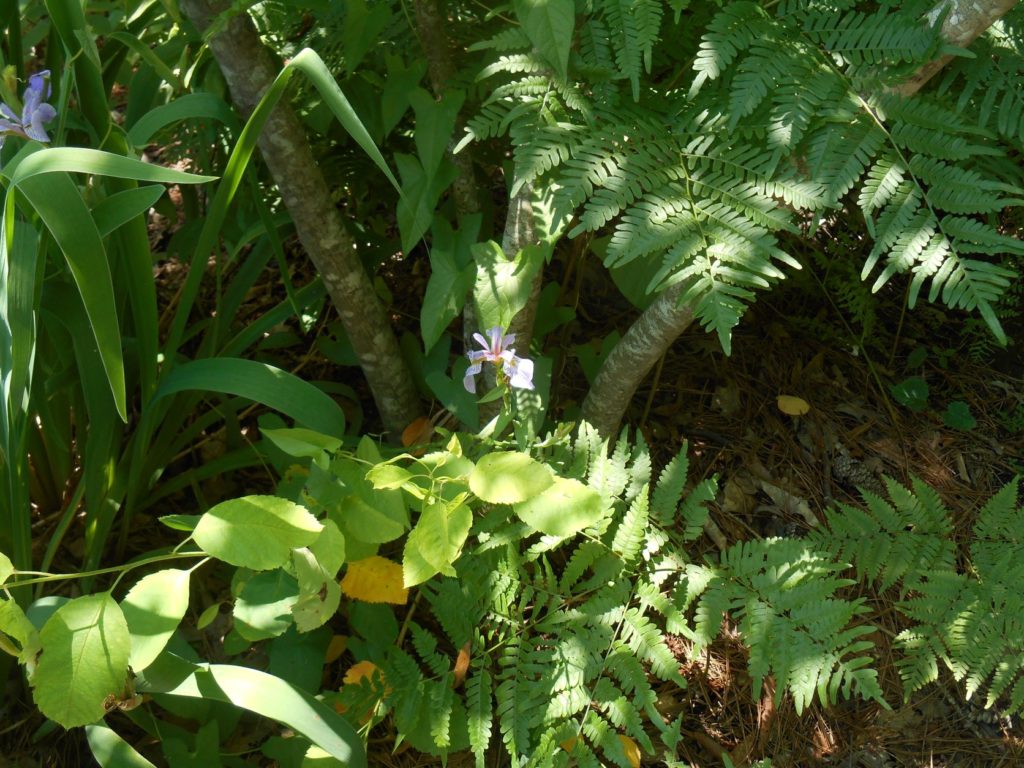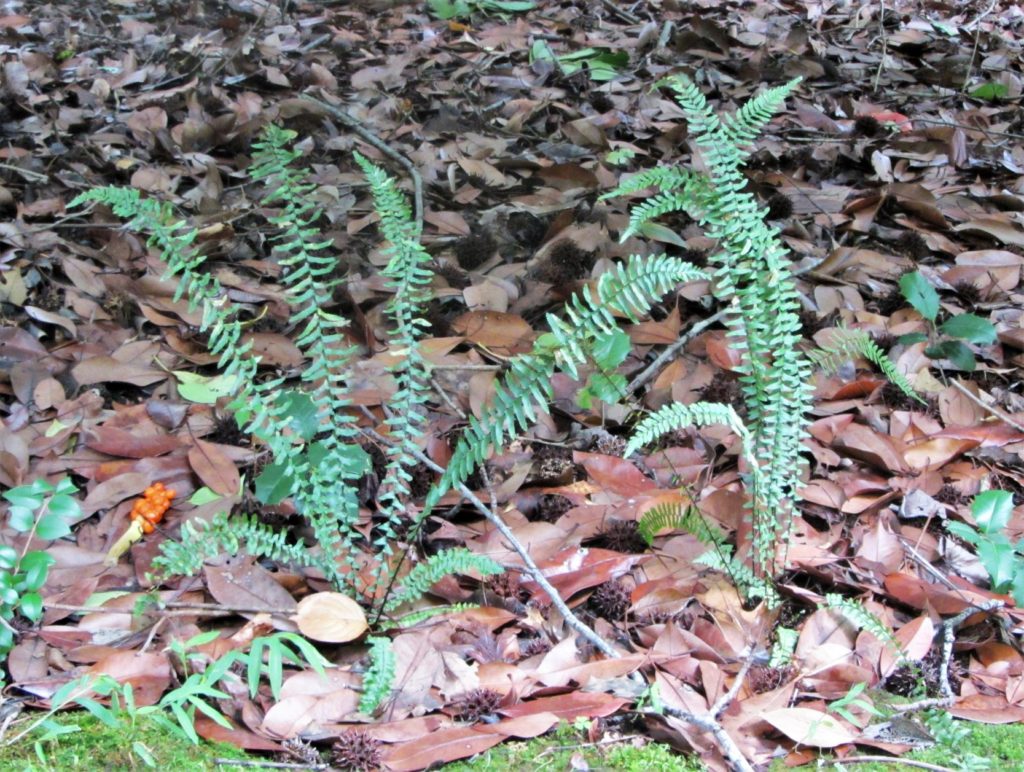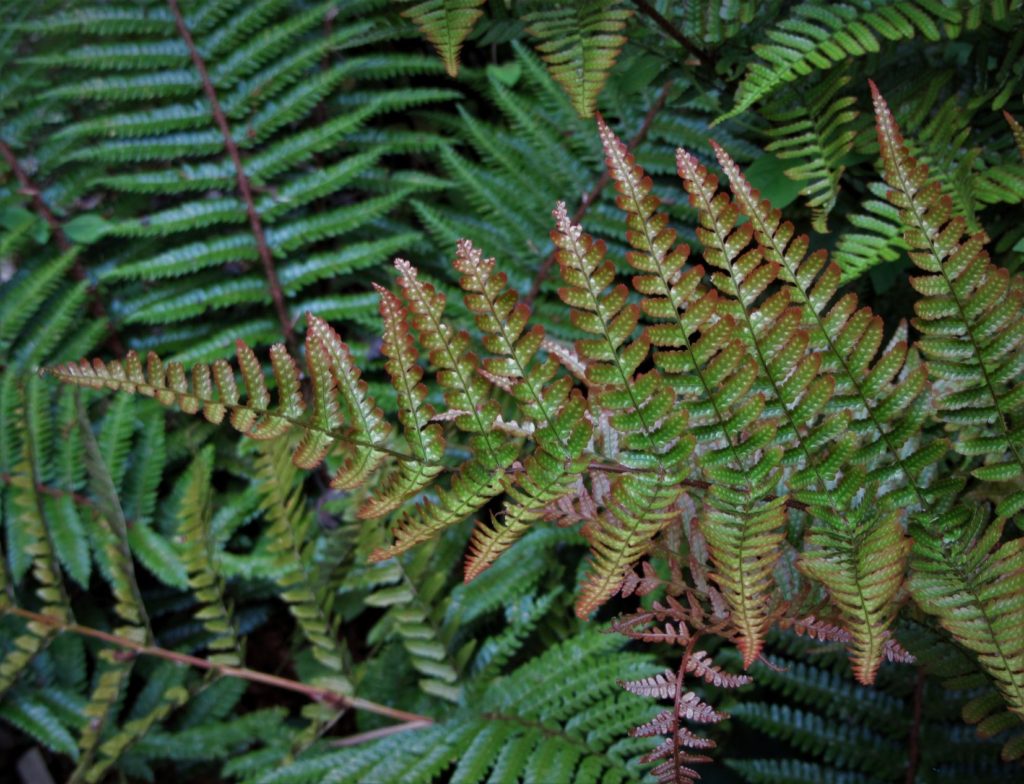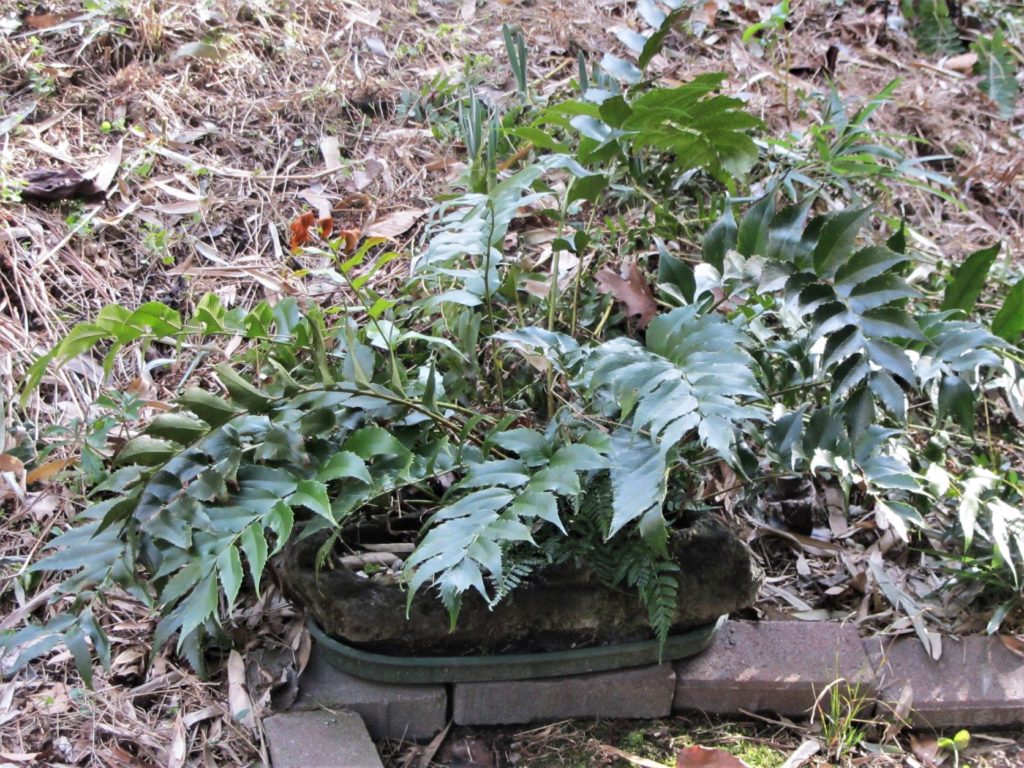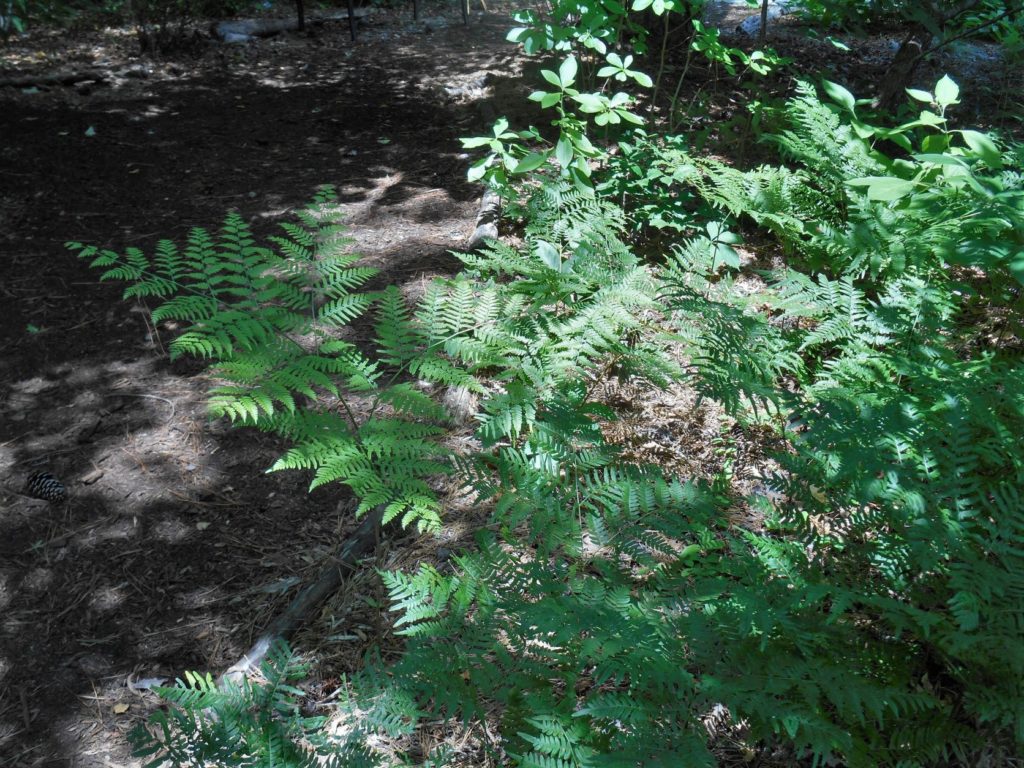Fabulous Ferns for Every Garden
You might find it odd to plant ferns in the fall. Many gardeners associate ferns with springtime, when fiddleheads break ground and unfold themselves as spring bulbs begin to bloom. Emerging fronds form a lacy backdrop in woodland plantings. But evergreen ferns prove a wise investment for gardeners planning winter pots, baskets and borders. Planting perennial ferns in fall gives them a head start on the year ahead.
Why Ferns?
Why do gardeners use ferns in their designs? Ferns form an important layer in the landscape, especially in shady gardens. Peaceful and calming, they grow lushly, providing both structure and interesting texture. Some may dismiss ferns as uniformly green, but many varieties provide vibrant color. Ferns make excellent ground cover, specimen and filler plants. While some grow as single fronds arising from a rhizome, or in small vase-shaped clusters, many ferns spread to form larger and larger clumps over time.
Ferns are very easy to grow, needing little care. They rarely have any sort of disease or pest, and neither chemicals nor machines are needed to care for them. All types of ferns are perennials and grow better with the passing years.
Like other plants, ferns inhale large amounts of carbon based ‘greenhouse’ gasses and sequester the carbon in their tissue and purify the air as they produce oxygen. This makes them an excellent choice for houseplants. Tender fern varieties may spend winters indoors and live outdoors when temperatures remain above freezing.
What are Ferns?
Ferns are the oldest vascular plants. Their roots absorb water and nutrients and anchor them in the earth. Veins transport water and sugars to every cell, unlike their mossy and algae ancestors, which have no circulatory system. They first appeared in the fossil record about 360 million years ago; long before any seed-bearing plants like conifers and flowering plants (trees, shrubs, grasses and other herbaceous plants) appeared, and grow on every continent on Earth.
Ferns are foliage plants that never produce flowers or seeds. Ferns reproduce through spores. This process requires a gametophyte stage that needs constant moisture, and a sporeling phase, which matures into what we recognize as a fern. A mature fern produces spores, and the spores grow into gametophytes. The gametophytes produce the egg and sperm cells which unite to produce the next generation of sporeling.
Myths About Ferns
Common myths may discourage some gardeners from investing in ferns, causing them to believe that growing ferns well is somehow complicated or risky. Some may expect ferns to be fussy and hard to grow. But experience proves ferns, even delicate looking ferns, tough and adaptable. They will thrive in a wide range of conditions and in many types of soil. As with many perennials, they need a bit of extra care until their roots establish. Once they have grown into the surrounding soil, they manage to keep themselves alive quite well.
Some ferns prefer uniformly moist, or even wet soil. Some native Virginia ferns, like Thelypteris palustris and Woodwardia virginica, grow well in marshes, ditches, and along waterways. But not all mature ferns require constantly moist soil. And many grow deep roots, allowing them to find sufficient moisture when rain is scarce.
Likewise, many ferns adapt well to partial sun. Though few can stand full sun in the summer, many will grow well with several hours of sun so long as they have some shade from surrounding buildings or trees during part of the day. Many ferns will grow in full shade, where little else can survive. But they will also grow with more available light.
Ferns adapt to a wide range of temperatures. Since ferns can be found on all continents, from the equator to the polar regions, they have developed many adaptations that allow them to cope with a variety of types of weather. Most want high humidity, though, and that makes them thrive in our hot, humid summers.
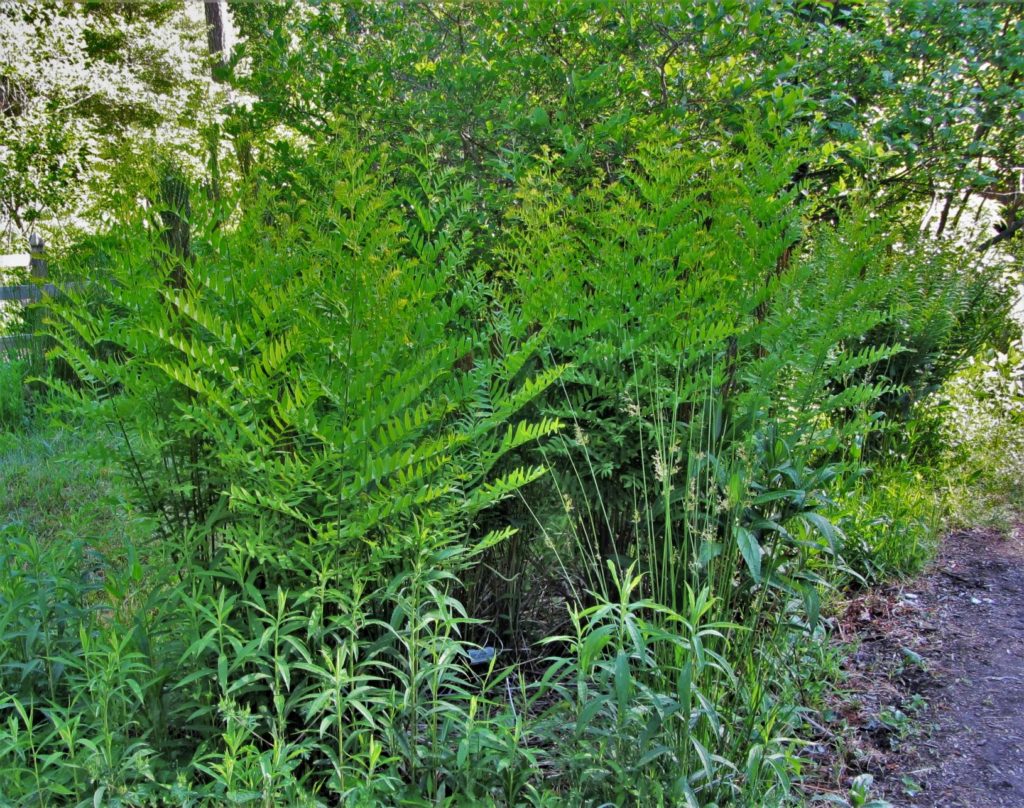
Royal fern, Osmunda regalis var. spectabilis, grows in the edge of wetlands at the Williamsburg Botanical Garden. Good for rain gardens, this fern can grow in wet soil.
Gardeners have more success when they do a bit of research on a plant before bringing a new variety home. As with anything else, find out how large a fern will grow, how much it might spread, and what conditions it needs to thrive. Plant tags provide some, but usually not enough information.
Look for ferns labeled with the plant’s botanical name. Ferns sold under only common names or nicknames may not actually be the species or cultivar that you think they are.
Some ferns spread aggressively on their rhizomes, just under or just above the soil. Within five years they may cover many square feet of ground. Other ferns grow in a clump that may widen over the years, but won’t spread very far from the original planting. Choosing native ferns and siting them appropriately almost guarantees success.

Ebony spleenwort, Asplenium platyneuron, grows from between bricks in the wall surrounding Bruton Parish in Colonial Williamsburg. This photo was taken in mid-December 2018, after several frosts.
Ferns Solve Many Garden Challenges
Many gardeners and landscape designers have specific criteria for choosing what to plant. Whether challenges come from the garden’s site, micro-climate and surroundings, or from the gardener’s own physical limitations, ferns often fit well in difficult situations. Whether you are trying to plant in a low, wet area or in dry shade; there is a good fern for that spot.
Deer and other herbivores rarely graze ferns. They won’t need fences, screens, or repellents to protect them. Likewise, only a few native ferns serve as lepidoptera host plants. Insects rarely damage ferns.
Ferns grow well on slopes that may be too steep for other types of ornamental plants, and their deep, spreading roots can help halt erosion and absorb run-off. They won’t require pruning. Depending on the variety, some trimming or cleaning up may be required once or twice a year. Most ferns are very long-lived. Plant once and enjoy for many years to come.
Taller ferns help screen awkward or unsightly areas. Evergreen ferns like Dryopteris erythrosora, Cyrtomium and Polystichums remain tall and green through the winter. They can be planted in pots or beds to give structure to the winter garden. Use evergreen ferns, instead of shrubs, in foundation plantings and along property lines.
Some ferns, like Athyriums, are deciduous perennials. Deciduous ferns mix well with spring bulbs. The bulbs bloom as the ferns are just beginning to emerge. As the ferns grow, they hide the bulbs’ leaves. It is helpful to mark where deciduous ferns grow so you don’t plant over them in early spring.
How to grow ferns?
Ferns can be very adaptable and grow in a variety of situations. Some are even epiphytic and can grow from the bark of trees and along large branches. Some will grow on rocks and from cracks in walls. I once collected several native ebony spleenworts growing on a juniper shrub in full sun.
Grow tender ferns in pots that can come indoors. Hardy ferns can grow in pots, troughs or hanging baskets, depending on the fern’s size and root mass. As hardy ferns age and need more space, move them into permanent spots in the garden.
Use good commercial potting soil in a pot, mixed with some pine bark or compost to improve drainage and add nutrition. Feed potted ferns once or twice a year with compost, a balanced time release fertilizer or a diluted liquid fertilizer, like fish emulsion. Ferns mix well with annuals, perennials, spring bulbs, and with other ferns. So long as all the plants in the arrangement have similar needs for moisture and light, they will weave together into a beautiful planting.

Deciduous hardy ferns, like this Southern maidenhair fern, will die back to the soil after frost and remain dormant until early spring.
Use ferns as ‘shoes and socks’ plants under and around trees and shrubs. Ground cover ferns can be as helpful as mulch to woody plants, and they are far better than turf for a tree’s health. Ferns like the ‘duff’ of decaying sticks and leaves on the forest floor. Enrich the soil with compost before planting your fern in the ground and mulch around the fern with chipped leaves or shredded bark after planting.
It is wise to know whether a particular fern prefers acidic, neutral or sweet soil before siting it. In most cases, neutral soil will work fine. Ferns that naturally grow on limestone rocks may benefit from a gravel mulch and will thrive in a concrete container. Ferns that want a more acidic soil will benefit from mixing shredded pine bark into the soil and using pine bark or shredded leaf mulch.
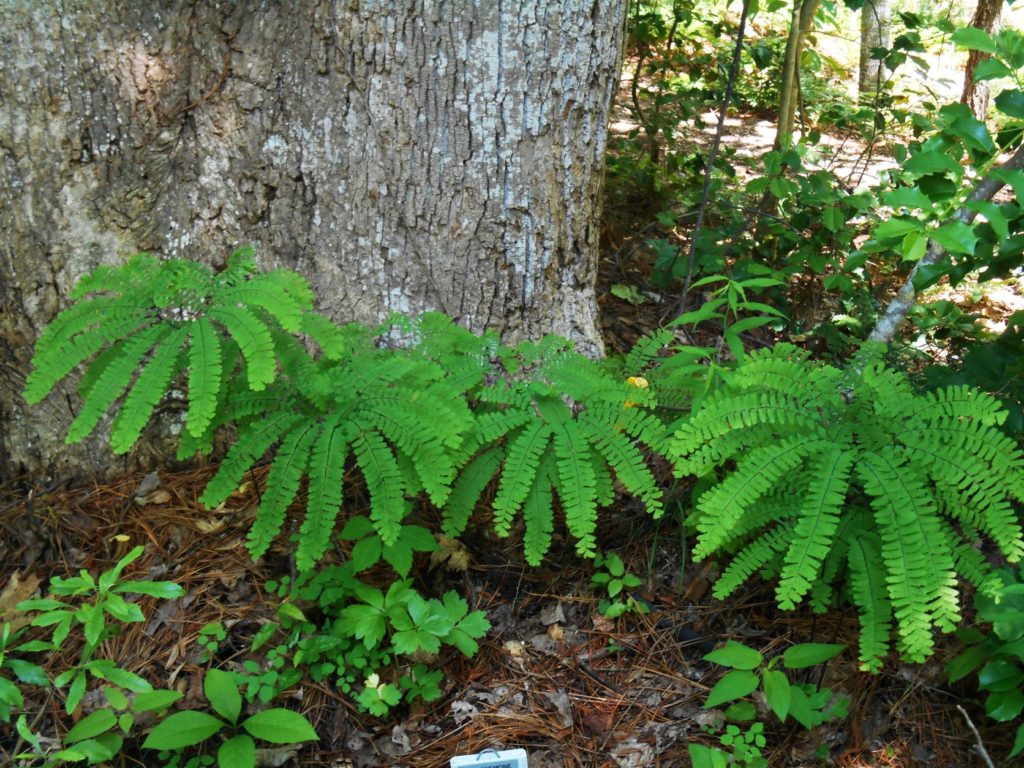
Northern maidenhair ferns, Adiantum pedatum, grow as ‘shoes and socks’ groundcover at the base of a tulip tree.
An interesting way to grow ferns is on a ‘fern table.” This elevates the forest floor on a flat surface and accommodates an arrangement of ferns, mosses, vines and perennials grown amid pieces of downfall wood and stones. Soil is mounded up, contained by wood, stones, moss and the roots of the ferns themselves. Like potted arrangements, this will need frequent water and occasional grooming and editing.
Most ferns like morning sun but need protection from strong direct afternoon sun. Deep to dappled shade works for most ferns. The sunnier the spot, the more moisture most ferns will require.
Which Ferns Are Best in Our Area?
There are many beautiful ferns native to Virginia. Some, like the Christmas fern are evergreen and others, like lady ferns, lose their leaves in fall. It can be difficult to find many of our natives in local nurseries. Forest Lane Botanicals, in York County, specializes in hard to locate native ferns.
Many ferns commonly available at nurseries or through mail-order sources are Asian, European, or Australian ferns. Some popular ferns are named cultivars. They may be of the same genus as native Virginian ferns but will have some variations in appearance. Interesting new hybrids and cultivars come to the market each year.
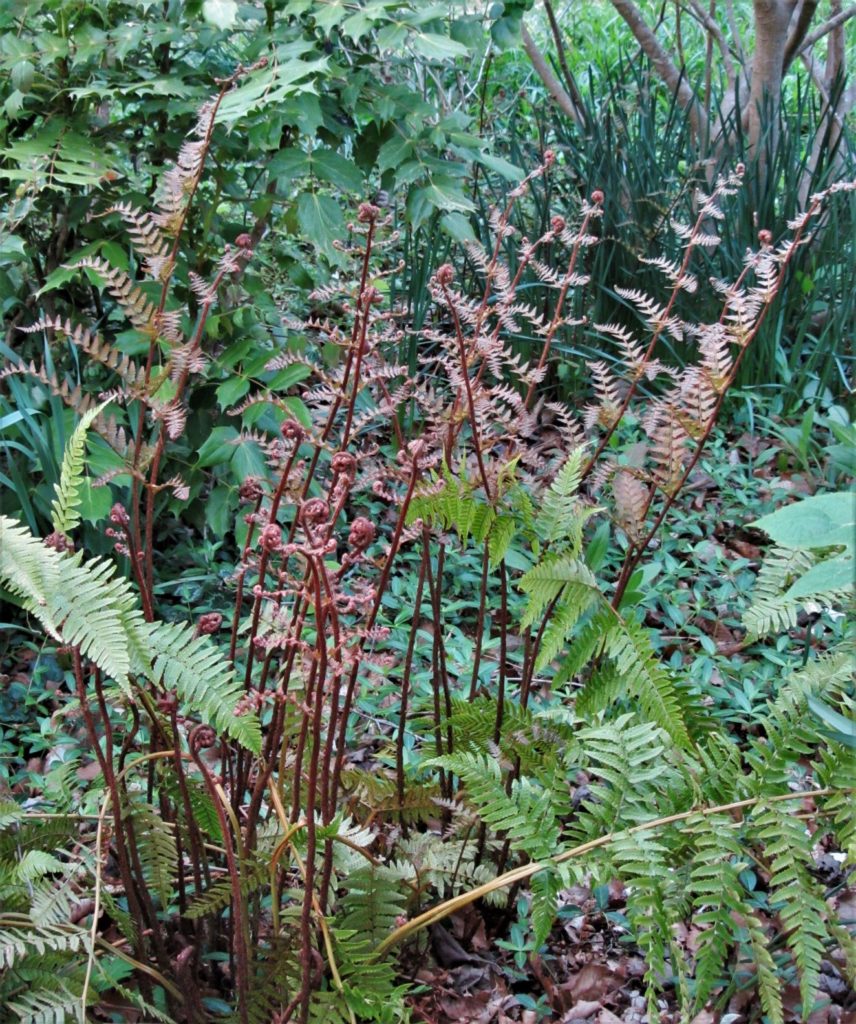
Named cultivars, like this Dryopteris erythrosora ‘Brilliance,’ may have similar needs and growth habits as native ferns of the same genus.
Once familiar with the main fern genera, it becomes easier to select ferns with the characteristics you want, whether they are native, hybrid, or imported.
When deciding whether to plant a native fern or one imported from another area, consider:
The plant’s purpose and use
The gardener’s need and intent
Potential invasiveness or area of spread
Potential crowding of other native plant species
Support for indigenous wildlife
Adaptability to local conditions
Right plant : Right place
Since ferns aren’t crucial as native insect hosts, and don’t feed any particular native animal species, other considerations may carry more weight. Ultimately, “Right plant, Right place” is the best guidance. Choose a plant that will thrive in the conditions you have to offer, that meets the gardener’s needs, and that won’t crowd out native plant species.
Major Genera of Ferns Commonly Grown in Our Area
Adiantum, Arachniodes, Asplenium, Athyrium, Botrypus, Cyrtomium, Dennstaedtia
Dryopteris, Matteuccia, Onoclea, Osmunda, Osmundastrum, Phegopteris,
Polypodium, Polystichum, Pteris, Pteridium, Pyrrosia, Thelypteris, Woodwardia
A single genus may include fewer than a dozen species, or it may include several hundred. Individual ferns, like our native cinnamon fern, Osmundastrum cinnamomeum, sometimes get moved out of one genus and into another. Anyone interested in ferns should choose a few selections they like and learn about them by growing them. A wide variety of ferns may be observed in nature in parks and local woods. The Williamsburg Botanical Garden (WBG) has an extensive collection of native and non-native ferns for visitors to enjoy.
Here are a few ferns recommended for Williamsburg Gardens:
Adiantum pedatum, Northern Maidenhair Fern Zones 3-8 (Native)
Height- varies by variety, to about 24” with spreading habit
Deciduous
Part to full shade, woodland fern
Tolerates sweet, or calcareous soil
Adiantum capillus-veneris, Southern Maidenhair Fern Zones 7b-10 (Native)
Height- 12”-18” with spreading, pendulous habit
Deciduous
Part to full shade, woodland fern
Likes sweet, or calcareous soil
Widely distributed, many named selections
Adiantum Family: Pteridaceae
Asplenium platyneuron, Ebony Spleenwort (Native)
Height- a few inches to 14” with clusters of fronds, will spread on rhizomes
Evergreen
Part sun to full shade
Will grow in woodlands, on logs, rocky banks, in mortar between bricks, in hanging baskets
Likes calcareous medium
Sometimes confused with the Christmas fern, but the stipe is dark brown, and the plant is smaller.
Athyrium asplenioides, A. felix-femina, Southern Lady Fern (Native)
Height- varies by variety, 3’-6’ with spreading habit
Zones 4-8
Deciduous
Part sun to full shade
Prefer moist, acidic soil and may volunteer within their range
Fronds are lacy and may be crested
Plants grow in dense vase-shaped clumps

Japanese painted ferns have been hybridized extensively. Many beautiful varieties are available with variations in coloration and form. These hardy deciduous ferns are easy to grow.
Athyrium niponicum var. Pictum, Japanese Painted Fern (Asian)
Height- 18”- 24” with spreading habit
Zone 4-9
Deciduous, late to leaf out in the spring
Light to full shade
Prefers moist, acidic soil enriched with organic matter
Fronds are lacy and may be crested. Burgundy stipes, silver highlights

Eared lady fern, Athyrium otophorum, displays a variety of colors as the fronds mature. It retains its burgundy stipes.
Athyrium otophorum Earled lady fern (Asian)
Height 1′-2′
Zone 6-9
Deciduous, but holds its fronds deep into winter
This is a woodland plant and performs well in partial sun to shade.
Prefers rich, acidic moist soil. Grows well in pots or planted into a bed.
Other Athyrium cultivars of interest:
Ghost, Metallica, Burgundy Lace, Applecourt, Regal Red, Godzilla, Branford Beauty
Athyrium family: Athyriaceae
Cyrtomium Holly Fern (Asian)
Cyrtomium falcatum (zone 7-10) and Cyrtomium fortunei (zone 5-10) are common in this area
Height 12”-30” tall with clumping habit
Evergreen
Very large, showy, leathery pinnae
Prefers moist soil, often native to limestone habitats
Grows in deep shade, but can tolerate sun in damp soil
Grow indoors or out
Cyrtomium Family: Dryopteridaceae
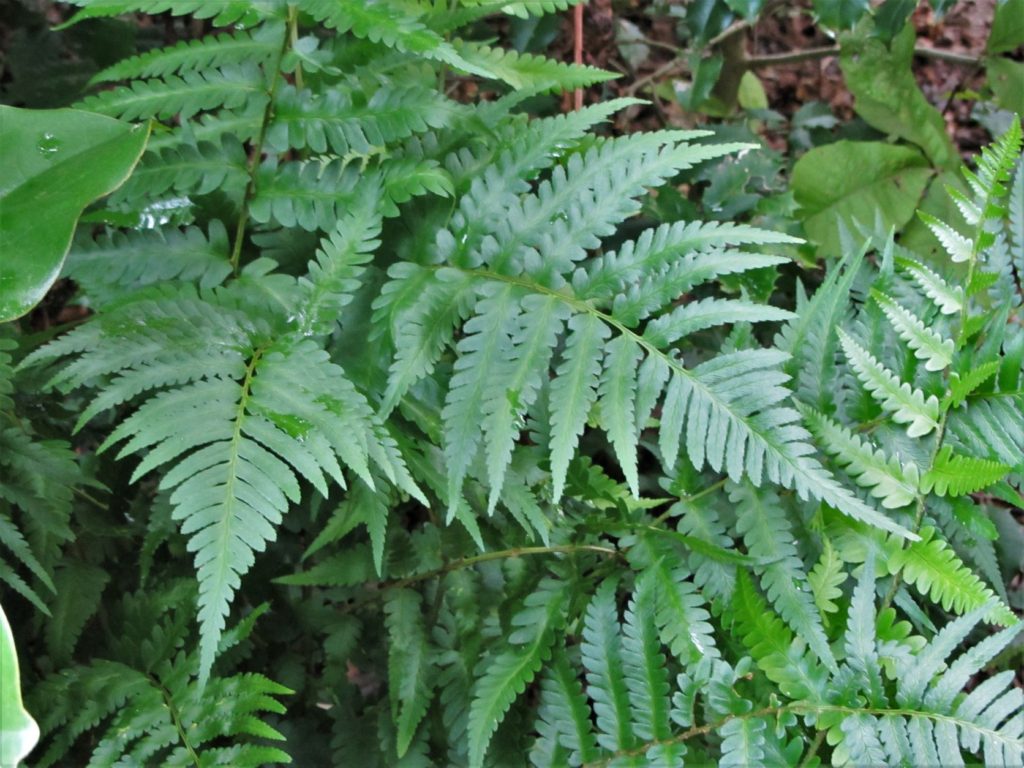
Dryopteris x australis is a natural hybrid of two native wood ferns. It grows to 5′ tall and remains green late into winter.
Dryopteris Wood Fern
Native in temperate North American, Europe, Japan and Asia
Prefers moist, acid soil, drought tolerant
Grows in deep shade, but can tolerate sun in moist soil
Vase shaped clumps of fronds, from dwarf to around 6’ tall. Some varieties may spread.
Scaly fiddleheads and stipes
225+ species and more than 70 hybrids.
Family: Dryopteridaceae
Common Dryopteris species and cultivars:
Dryopteris filix-mas, male fern is native to Europe, Africa and parts of Asia, and is found in North America. Zones 4-8
Dryopteris x australis, Dixie wood fern, is native in the Southeastern US Zones 5-9
Dryopteris cristata, Crested wood fern, is native in temperate areas of North America and Europe. Zones 3-8
Dryopteris erythrosora, Autumn fern, Asian species with numerous hybrids, Zone 6b-12
Dryopteris intermedia, Fancy fern, is native in the Eastern US Zones 3-8.
Dryopteris labordei ‘Golden Mist’ Asian species with attractive new golden fronds, hardy in Zones 5-8 to 2′ tall
Dryopteris ludoviciana, Southern wood fern is native in swampy areas of the Southern US zones 6-9.
Dryopteris celsa, Log fern, a fertile hybrid native to the Southeastern US Zones 4-9 that can grow on rotting logs and stumps.
Dropteris wallichiana ‘Jurassic Gold.’ Selection of a common Asian species hardy in Zones 6-8 to 2′ tall
Dryopteris family: Dryopteridaceae
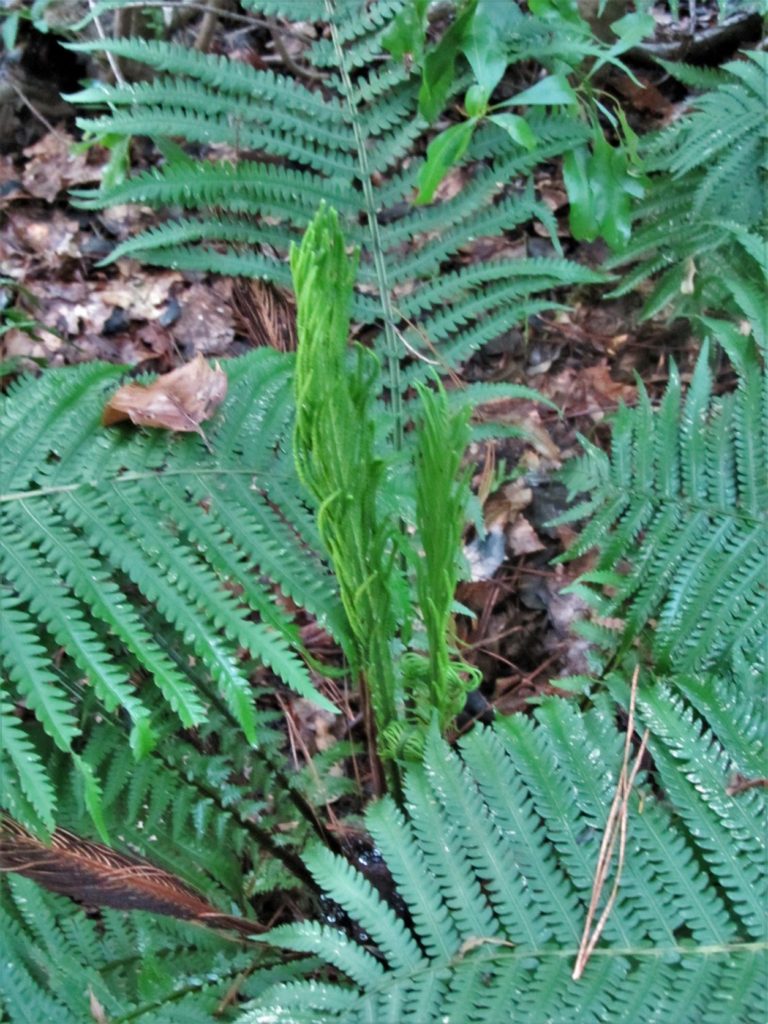
Fertile fronds emerge green on the Ostrich fern, turning brown in fall. Spores release during early spring.
Onoclea
Hardy, deciduous ferns in Zones 2-10
Runners from rhizomes spread aggressively
Sterile fronds are upright and 2’-6’ tall
Fertile fronds appear in summer. Spores may be released in winter or spring
Prefers moist soil in deep shade to partial sun
2-5 species native to Asia and Eastern North America
Onoclea struthiopteris, Ostrich Fern (native) formerly, Matteuccia struthiopteris
Native in North America from Canada to the mid-Atlantic, and also in Europe, Japan, and much of northern Asia.
Hardy in Zones 2-8, it doesn’t like extended hot summers, and so doesn’t naturalize well in warmer climates.
Deciduous, dimorphic highly ornamental, grows 2-6’ tall in moist, fertile soil and partial to full shade.
Prolific runner, fills what space is allowed as new clumps emerge from its running rhizomes.
One of the earliest ferns to emerge each spring.
Fertile fronds emerge green and turn dark brown as the sporangia ripen. They persist, standing up right, into the following season, marking the spots where clumps of new fronds will emerge in spring.
Spores released in early spring
May be confused with the cinnamon fern, but the fertile fronds have a different shape
Fiddleheads are edible and may be considered a delicacy in some areas.
Onoclea sensibilis, Sensitive Fern (native)
Native to North America east of the Rocky Mountains.
Hardy in Zones 2-10, this very adaptable fern will colonize expanding areas in moist soil.
Grows in woodlands, along ditches and roadsides, in wetland areas and in beds and borders. It is common in every county in Virginia.
Dimorphic, with fertile fronds appearing in late summer. Fertile fronds appear to be covered in green beads, which turn brown and woody.
Very frost sensitive. Non-fertile fronds die back after the first frost,leaving only the fertile fronds standing through winter. Spores emerge in late winter.
Often confused with Woodwardia areolata, but can be distinguised by its fertile fronds, wavy pinnae margins and taller stature
Onoclea Family: Onocleaceae
Osmunda regalis var. spectabilis Royal Fern
Hardy, deciduous ferns in Zones 2-10
Sterile fronds are upright and 2’-6’ tall
Fronds are bold, with large pinnae
Fertile fronds appear in summer. Spores ripen in a few weeks
Prefers moist, acidic soil in full to partial sun
Can grow in standing water
Royal fern is found around the world. Several species have been moved out of this genus, including Interrupted fern and Cinnamon fern
Osmunda Family: Osmundaceae
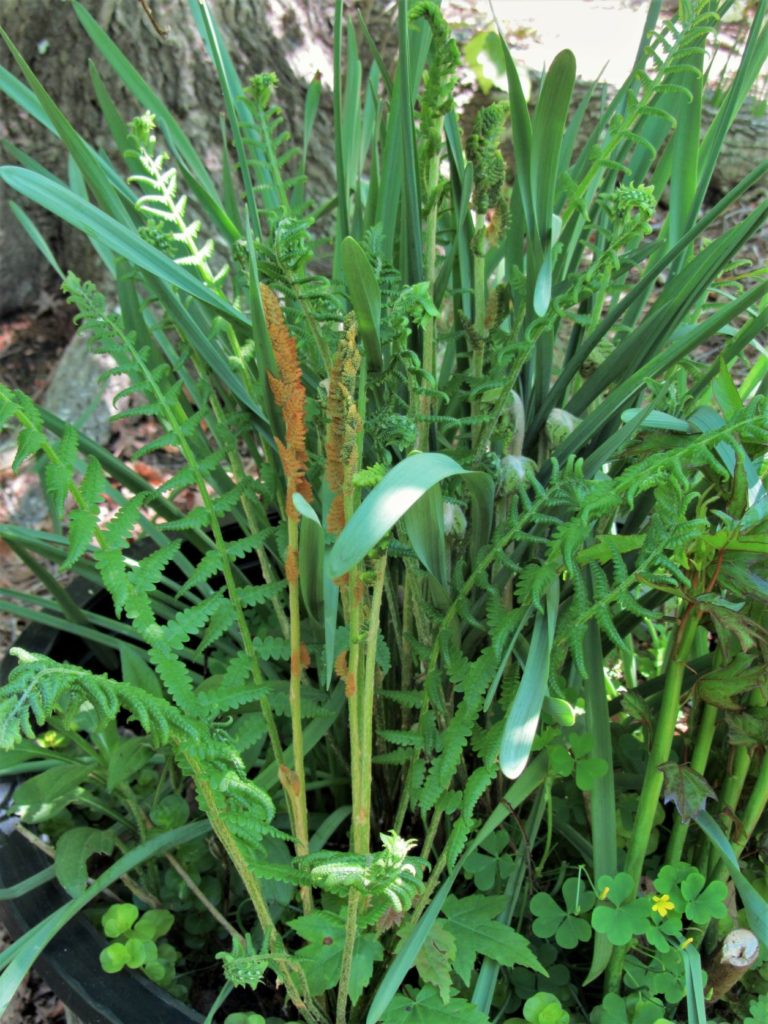
Cinnamon Fern, Osmundastrum cinnamomeum, have fertile fronds at the same time sterile fronds emerge. Fertile fronds are brown throughout the season.
Osmundastrum cinnamomeum Cinnamon Fern (Native to North and South America)
Hardy in zones 2-10
Deciduous, dimorphic fronds 3’-5’ tall
Arching sterile fronds emerge in circular clusters that spread
Fertile fronds emerge late summer
Prefer moist, acidic soil in part to full shade
Osmundastrum Family: Osmundaceae
Phegopteris hexagonoptera, Broad Beech Fern (Native in Eastern North America)
Hardy, deciduous fern in Zones 5-8
Broad, showy fronds to 12″ emerge from spreading rhizomes
Identify by the lowest pinnae that tilt back, away from the others
Woodland plant tolerates various soil types, drought tolerant
Grow in part to full shade, can tolerate more sun if the soil is moist
Phegopteris family: Thelypteridaceae
Polystichum Shield Fern
Hardy, evergreen ferns in Zones 3-9
Prefer moist, but not wet soil in light shade to part sun
Polystichum acrostichoides Christmas Fern (Native in Eastern North America)
Evergreen in Zone 3-9
Forms crowns to 2’-3’ tall on slowly creeping and branching rhizomes.
Glossy green dimorphic fronds. Fertile fronds narrow at tips.
Tolerates many soil types, drought tolerant.
Polystichum polyblepharum Tassel Fern (Asian)
Evergreen in Zones 6-9
Forms a broad crown to 2’ tall
Prefers moist, rich soil in light shade.
The rhizome forms a trunk to 5”, doesn’t spread
Polystichum Family: Dryopteridaceae
Pteridium aquilinum, Bracken Fern (native)
Deciduous, hardy in Zones 3-10
Fronds arise 2’-4’ from a rapidly creeping rhizome. Forms colonies
Fronds are wide and deeply divided, lacy
Prefers moist, acidic soil in full to part sun
Fronds are highly poisonous if ingested
Pteridium Family: Dennstaedtiaceae
Thelypteris noveboracensis (syn. Parathelypteris noveboracensis) New York Fern (Native)
Deciduous hardy fern in Zones 3-8
Height 1’-2’ tall on creeping rhizome
Upright yellow-green fronds emerge in clusters along the rhizomes
Prefers moist to wet acidic soil along waterways and ditches
Dappled sunlight to partial shade, can be used in a rain garden
Identify by the frond tapering at top and bottom
Thelypteris palustris, Marsh Fern (Native)
Height 18”-30” tall on creeping rhizomes
Deciduous hardy fern in Zones 3-8
Prefers wet soils near swamps, ditches and waterways
Full sun to part shade, can be used in a rain garden
Thelypteris Family: Thelypteridaceae
Woodwardia, Chain Fern (Northern Hemisphere species)
Deciduous hardy ferns in Zones 3-9
Fronds arise singly from a long creeping and branching rhizome
Prefer moist, acidic soil in full to part sun
Can grow in wet, boggy areas
Woodwardia areolata, Netted Chain Fern (Native)
Fronds are dimorphic and grow to 2’ tall and 8” wide.
Sori, on the underside of fertile fronds, appear as links in a chain.
Lives in swamps and wet woodlands
Woodwardia virginica, Virginia Chain Fern (Native to Eastern North America)
Dimorphic fronds emerge from long creeping rhizomes and grow to 4’ tall
New leaves yellowish, turning glossy green as they mature
Ferns prefer to grow in mud or standing water in full to part sun
Woodwardia Family: Blechnaceae
For Further Reading:
Hamilton, Helen. Ferns & Mosses of Virginia’s Coastal Plain. Owen Printing Company. Petersburg, Virginia. 2017.
Steffen, Richie and Sue Olsen. The Plant Lover’s Guide to Ferns. Timber Press. Portland, Oregon. 2015.
The Williamsburg Botanical Garden Fern Collection – Plants Map
The Hardy Fern Foundation: https://hardyferns.org
All photos by Elizabeth McCoy
Elizabeth McCoy is a JCCW Master Gardener, class of 2018, a Tree Steward and a former Williamsburg Botanical Garden volunteer.






